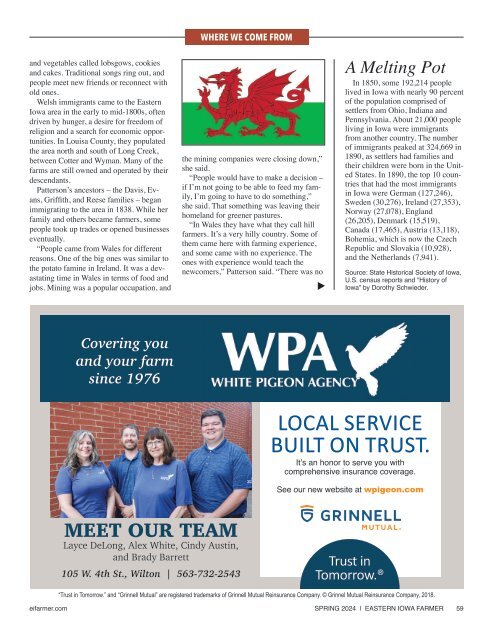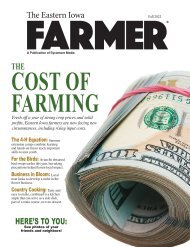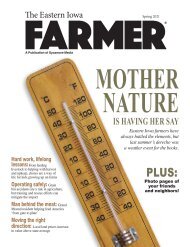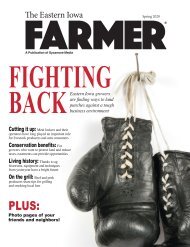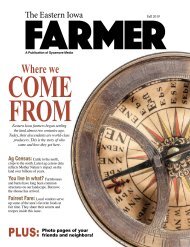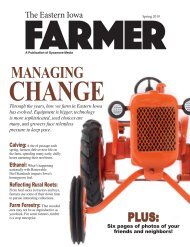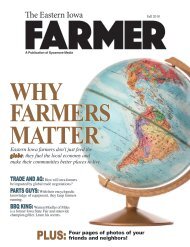You also want an ePaper? Increase the reach of your titles
YUMPU automatically turns print PDFs into web optimized ePapers that Google loves.
and vegetables called lobsgows, cookies<br />
and cakes. Traditional songs ring out, and<br />
people meet new friends or reconnect with<br />
old ones.<br />
<strong>We</strong>lsh immigrants came to the Eastern<br />
Iowa area in the early to mid-1800s, often<br />
driven by hunger, a desire for freedom of<br />
religion and a search for economic opportunities.<br />
In Louisa County, they populated<br />
the area north and south of Long Creek,<br />
between Cotter and Wyman. Many of the<br />
farms are still owned and operated by their<br />
descendants.<br />
Patterson’s ancestors – the Davis, Evans,<br />
Griffith, and Reese families – began<br />
immigrating to the area in 1838. While her<br />
family and others became farmers, some<br />
people took up trades or opened businesses<br />
eventually.<br />
“People came from Wales for different<br />
reasons. One of the big ones was similar to<br />
the potato famine in Ireland. It was a devastating<br />
time in Wales in terms of food and<br />
jobs. Mining was a popular occupation, and<br />
WHERE WE COME FROM<br />
the mining companies were closing down,”<br />
she said.<br />
“People would have to make a decision –<br />
if I’m not going to be able to feed my family,<br />
I’m going to have to do something,”<br />
she said. That something was leaving their<br />
homeland for greener pastures.<br />
“In Wales they have what they call hill<br />
farmers. It’s a very hilly country. Some of<br />
them came here with farming experience,<br />
and some came with no experience. The<br />
ones with experience would teach the<br />
newcomers,” Patterson said. “There was no<br />
A Melting Pot<br />
In 1850, some 192,214 people<br />
lived in Iowa with nearly 90 percent<br />
of the population comprised of<br />
settlers from Ohio, Indiana and<br />
Pennsylvania. About 21,000 people<br />
living in Iowa were immigrants<br />
from another country. The number<br />
of immigrants peaked at 324,669 in<br />
1890, as settlers had families and<br />
their children were born in the United<br />
States. In 1890, the top 10 countries<br />
that had the most immigrants<br />
in Iowa were German (127,246),<br />
Sweden (30,276), Ireland (27,353),<br />
Norway (27,078), England<br />
(26,205), Denmark (15,519),<br />
Canada (17,465), Austria (13,118),<br />
Bohemia, which is now the Czech<br />
Republic and Slovakia (10,928),<br />
and the Netherlands (7,941).<br />
Source: State Historical Society of Iowa,<br />
U.S. census reports and “History of<br />
Iowa” by Dorothy Schwieder.<br />
Covering you<br />
and your farm<br />
since 1976<br />
LOCAL SERVICE<br />
BUILT ON TRUST.<br />
It’s an honor to serve you with<br />
comprehensive insurance coverage.<br />
See our new website at wpigeon.com<br />
MEET OUR TEAM<br />
Layce DeLong, Alex White, Cindy Austin,<br />
and Brady Barrett<br />
105 W. 4th St., Wilton | 563-732-2543<br />
Trust in<br />
Tomorrow.®<br />
“Trust in Tomorrow.” and “Grinnell Mutual” are registered trademarks of Grinnell Mutual Reinsurance Company. © Grinnel Mutual Reinsurance Company, 2018.<br />
eifarmer.com SPRING 2024 | EASTERN IOWA FARMER 59


